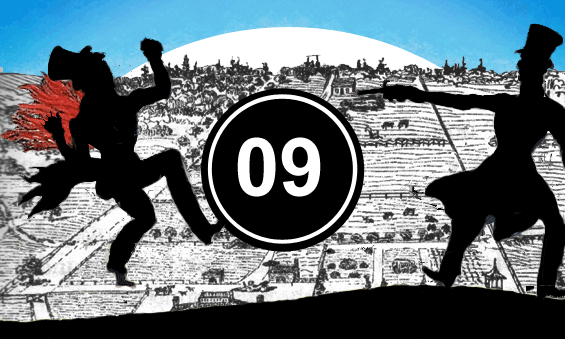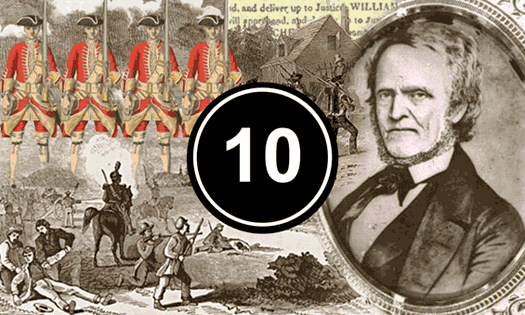 |
| Samuel Jarvis in the 1850s |
In 1781, William Jarvis got shot. They say it's probably the best thing that ever happened to him. Before that he was just an ordinary soldier, one of tens of thousands of Americans who stayed loyal to the British and fought on their side during the American Revolution. But when he got wounded during a battle in Virginia, he caught the attention of his commanding officer. And that commanding officer just so happened to be John Graves Simcoe, the guy who would soon be running all of Upper Canada. When Simcoe decided to build a new town on the banks of Toronto Harbour his first step was to give a bunch of free land to men he knew from his fighting days. Like William Jarvis.
Jarvis got a spot in town—at Sherbourne and Adelaide—plus one of the hundred-acre "park lots" (strips of land running between Queen Street and Bloor). It was, not surprisingly, right where Jarvis Street is now. In return, all he had to do was move here with his family, build a road around his property and totally suck at being a government administrator.
When you read anything about William Jarvis, the same kinds of adjectives keep popping up: "inefficient and careless", "incompetent and corrupt", "incompetent, lazy, selfish and dishonest". Even in early Toronto—a town crawling with incompetent, corrupt officials—he and his wife were hated. They bitched and moaned about everything; Jarvis once tried to challenge four men to a duel all at the same time, his wife called the other elites "a lot of Pimps, Sycophants and Lyars." And as if that weren't enough, they were one of the few Toronto families ever to have owned slaves.
Jarvis' son, Samuel, followed in his father's sucktastic footsteps. As a young man, he fought with the British against the Americans in the War of 1812, but then relied on his connections to land a cushy government job so he could settle down to a life of corruption, scandal and financial idiocy, just like his dad. And like his dad, he made lots of enemies.
Like, say, John Ridout. The details of their feud are a bit sketchy, but it seems like Jarvis probably owed the young law student money. He owed a lot of people money. What we do know for sure is that one day in the summer of 1817, Ridout came to see Jarvis at work and got thrown out of his office. Soon after that, they were fighting in the street. That's when Jarvis challenged him to a duel.
They met at dawn the next day in a meadow, at what's now the south-east corner of Yonge and College. Once they and their seconds had agreed to the rules, Jarvis and Ridout drew their pistols, turned their backs on each other, took eight steps and waited for the count: one... two...
Ridout fired early. And missed.
At first, there was confusion. No one was quite sure what to do; what the rules and honour dictated. But it was eventually decided that Ridout should return to the spot he'd fired from so that Jarvis could take a free shot. Which he did. The bullet hit Ridout right in the chest.
According to the autopsy, he died pretty much instantly, but by the time the authorities showed up, Jarvis and the seconds were claiming that he had lived just long enough to forgive them all and absolve them completely of any responsibility. The lying didn't work; Jarvis was arrested and charged with murder. Luckily for him, there were still plenty of people in those days who thought that firing guns at each other while standing a few meters away was the proper way to settle disputes, so Jarvis was acquitted.
But the controversy was far from over. The duel haunted him for years, and ended up playing an important role in the politics of Upper Canada. A decade later, his enemies were still using it against him. Worst of them all was a reform-minded newspaperman who had just moved to town: William Lyon Mackenzie. He hated the Jarvises and the rest of the handful of anti-democratic, pro-monarchy conservatives running things, nicknaming them the "Family Compact" and using his paper, The Colonial Advocate, to trash them every chance he got. He called some demons, some jackals, some funguses and Samuel Jarvis a murderer.
Jarvis was incensed. He rounded up a bunch of like-minded Tories, dressed them like indigenous peoples and attacked the newspaper's offices. While his wife and children hid in the basement, Mackenzie's whole operation was destroyed, his printing press broken, and all the typeface throw into Lake Ontario.
But the Type Riot backfired. Mackenzie sued the vandals, won, and used the money to fund an even bigger operation. Meanwhile Jarvis was reduced to defending himself in pamphlets with catchy titles like "A Contradiction of the Libel Under the Signature of 'A Relative,' Published in the Canadian Freeman, of the 28th February, 1828; Together with a Few Remarks, Tracing The Origin of the Unfriendly Feeling Which Ultimately Led to the Unhappy Affair to Which That Libel Refers". Within a few years, Mackenzie would be elected as the first mayor of Toronto, lead an attempted revolution and play an important in role in bringing true democracy to Canada.
But that's a story for another post...
-----
|
|
A version of this story will appear in The Toronto Book of the Dead Coming September 2017 Pre-order from Amazon, Indigo, or your favourite bookseller |
You can still see Jean Ridout's grave mounted on the wall inside St. James Cathedral downtown. And you can read Jarvis' pamphlet here. William Jarvis, despite the impression I've been under for months now, is NOT the same person as William Botsford Jarvis, one of our earliest sheriffs, co-founder of the village of Yorkville, and the guy who owned Rosedale back went it was a forested country estate. You can also read lots more about the Jarvis family on the Jarvis Collegiate website, which is quick to point out that the school was named after the street and not directly in honour of those jerks.
|
| This post is related to dream 09 The Ghost of John Ridout Samuel Jarvis, 1826 |
|
| This post is related to dream 10 The Battle of Montgomery's Tavern William Lyon Mackenzie, 1837 |











Great read. I do love that Ridout's headstone refers to Jarvis as a "Blight." The last word - in stone no less!
ReplyDeleteThat is one of my ancesters I this was a great read I can honestly say that my Side of the Jarvis family are nothing like that we are all hard working people.
DeleteThanks for the article. Sam Jarvis had a sister at a ladies college in Kingston but he was in a penurious state and had not paid her tuition. James Ridout insulted Sam Jarvis about him not paying his bills. Sam struck Ridout in the neck with his cane. Or the other way around, Ultimately a duel was called. I do believe the BLIGHT inscribed on the plaque in the doorway at St. Jame is in regards to a Blight on the Ridout family name as he was a coward. Young James, an 18 year old midshipman and familiar with weapons turned before the count of 9 or 8 , whatever_ and fired, dropped his pistol and was set up again by the seconds at Elmsley Farms, Bay and Wellesley College area and Sam Jarvis took his shot and killed the young man. The rest is history. Bev Campbell Toronto artist. historian
ReplyDelete